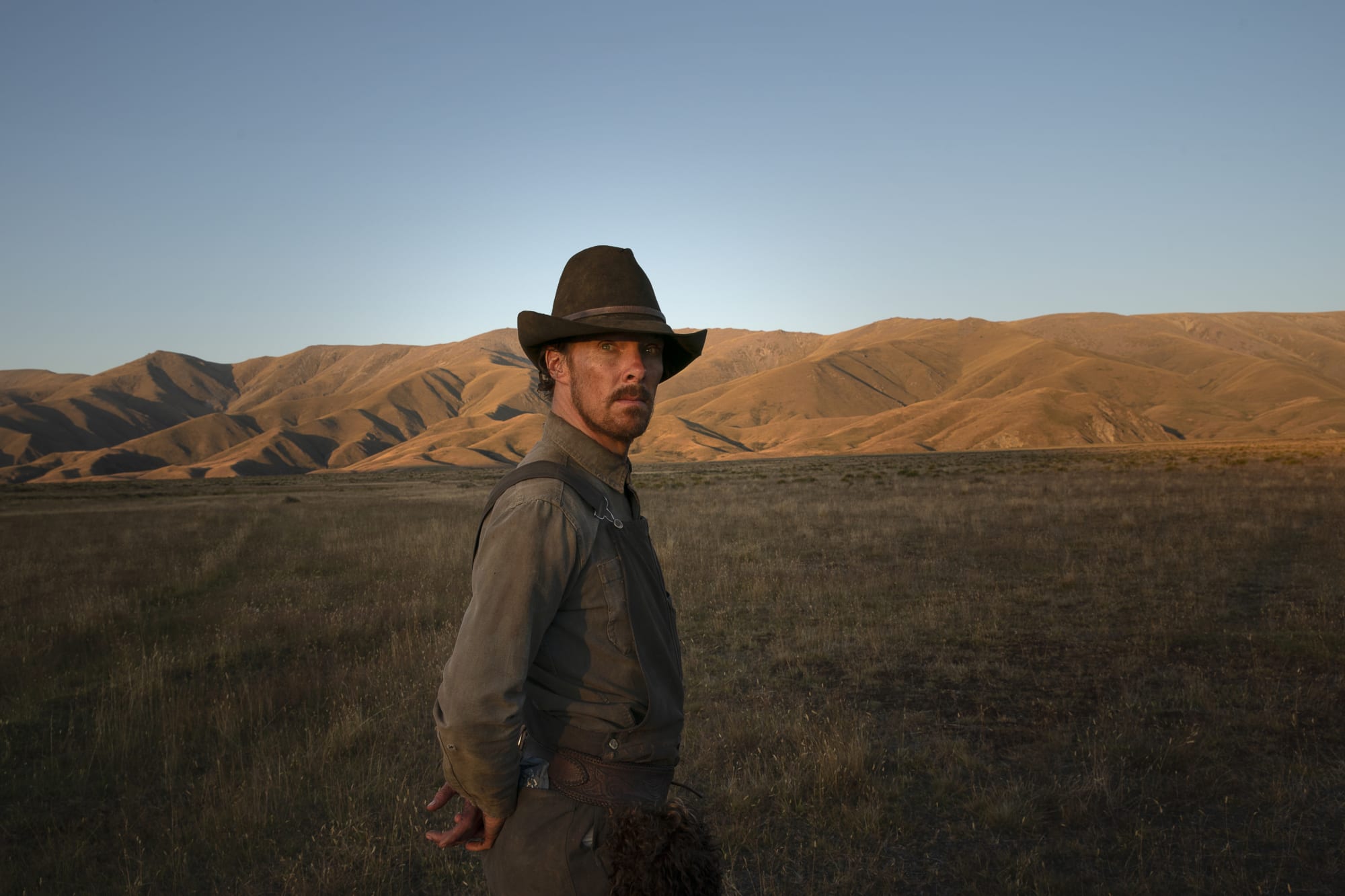
Move over, Psycho, Jane Campion has made a film challenging your position as the reigning Gothic film of classic Hollywood cinema.
In 1925 Montana, Phil Burbank (Benedict Cumberbatch) and his brother, George (Jesse Plemons) run a Montana cattle ranch. Phil is the older brother, who after beginning a brilliant academic career at a college back east, has returned to manage the ranch with his slower and more stolid brother, George. While on the trail to sell their cattle, Phil recounts to George and the other ranch hands stories about “Bronco Henry,” a mentor of Phil’s when he was younger. Bronco Henry, “that best of riders, that best of cowboys,” had been killed in a corral accident years ago, and Phil laments his passing and his absence from the cattle drive.
Together, Phil and George have formed an uneasy but strongly bonded familial partnership until George befriends a widow, Rose (Kirsten Dunst) who—with her son Peter (Kodi Smit-McPhee)—manage a hotel near where the ranchers end their cattle drive. Rose had moved to the area years before with her small-town doctor husband, but his drinking and depression ended with suicide, leaving Rose as widow, raising her boy, now a young man.
Much to Phil’s dismay, George courts and then marries Rose, and takes her and Peter back to the ranch. Phil has done everything possible to maintain the ranch exactly as it was when he and George were children, even to the point that the two brothers still sleep together in the same room. As Phil watches Rose bring unwelcome changes to house, he warns his brother that Rose has married him only for his money, a claim that is confirmed in his mind when George sends Peter off to college with a medical career in his future.
Phil begins a campaign to make Rose leave her husband and the ranch. After a series of mental tortures perpetrated by Phil, Rose starts to drink, and becomes an alcoholic.
Home from school, Peter, who is by nature introspective, spends his time studying diseases and dissecting animals with the goal of being a doctor. While seemingly absorbed with these hobbies, Peter observes how badly Phil treats his mother. One day Peter finds a secluded small cabin near the river that runs through the ranch, inside is a collection of magazines with photographs and illustrations of nude men. Peter keeps this secret to himself, but before he leaves the area of the cabin, he sees Phil bathing nude in the pond. Phil sees a surprised Peter staring at him and angry the boy has seen him in a vulnerable moment, chases him away.
Watching Peter’s unperturbed reaction to ranch hands when they call him sissy, Phil begins to realize Peter has hidden strengths and talents. Changing tactics, Philip befriends Peter, ostensibly to torment Rose even more, but also perhaps to groom him to become a friend and companion. Meanwhile, exploring the ranch trails, Peter finds a dead steer and knowing that anthrax is a possible cause of the animal’s death, he cuts off and preserves a piece of its hide.
The battle between Rose and Phil reaches a climax when Rose gives away Phil’s cowhides without his permission and incensed, Phil threatens to force Rose off the ranch. Knowing that Phil had been planning to use the cow hide to braid rope for a lasso, Peter offers Phil the hide he had cut from the dead cow on the trail, and the two spend the night braiding rope in the barn. The two smoke a cigarette together and Phil tells Peter that Bronco Henry saved his life one cold winter night sleeping next to him in a shared bedroll. When asked by Peter if they were naked together, Phil is silent.
The next day, Phil does not show for breakfast, and is found ill in his bed, his hand severely infected. Phil is taken to a doctor, but there is little to be done and Phil is quickly dead, leaving George to shop for a coffin while the village barber functions as undertaker, making Phil presentable for the funeral by giving the corpse a final shave and haircut. Instead of attending the funeral, with gloved hands, Peter procures the infected lasso from Phil’s room, and then reads a passage from the bible, Psalm 22:20: “Deliver my soul from the sword; my darling from the power of the dog.” He looks out the window to see his mother, sober for the first time in months, coming back to the house with George.
Ernst Lubitsch once famously advised directors not to spoon feed moviegoers, but to instead lead them to where they can come up with conclusions of their own, in his own words, “let the audience add up two plus two. They’ll love you forever.” Jane Campion is a star pupil in this Lubitsch School of Directing, although sometimes she uses differential calculus instead of simple addition to get to her final sum.
The Gothic trail that leads to Campion’s film starts with Christina’s World, a painting at the Museum of Modern Art in New York. Those of you familiar with Andrew Wyeth’s most famous work can visualize a stark country landscape with a woman, in the foreground, possibly crawling to a distant farmhouse.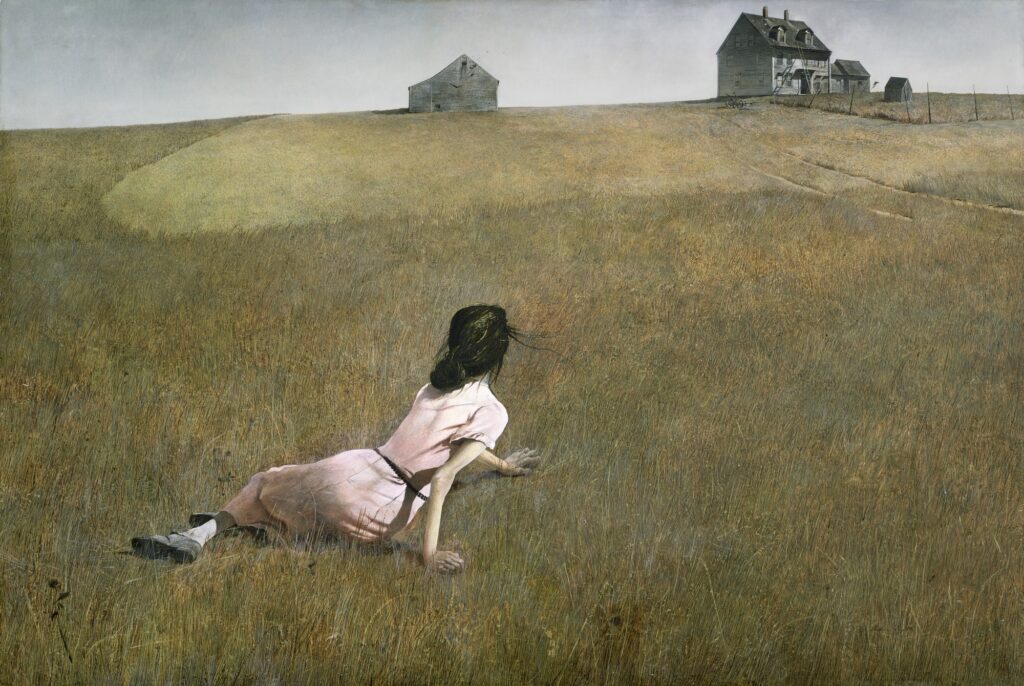
Art critic Helena Lamouliatte, in discussing Wyeth’s work, points out that while critics often focus on Wyeth’s works as being illustrative and theatrical, there is a “dark and less congruent dimension in Wyeth’s art, while being unable to pinpoint it precisely,” and that Wyeth has “created a very personal and original synthesis of European and American influences, with a deep Gothic undercurrent.”
In the case of Christina’s World, the Gothic elements of the painting are immediately evident: a mysterious house in the distance, and a woman seemingly in the act of moving toward the house. The figure (we assume Christina) crawls toward the house with determined purpose. Having a “faceless” figure, Wyeth invites us—indeed it almost forces us—to guess her state of mind. Does she move toward the house with joy or sadness, perhaps even boredom?
And what of Christina herself, sprawled on the ground, crawling toward the horizon—is she crippled, disabled, or victim of some heinous act? We can only speculate, and in that speculation the mystery of the situation only deepens. When we look for clues to solve this mystery by standing closer and peering deeply into the canvas, there are no answers, only more questions—and the knowledge we are seeing only part of a story that will never have an answer is profoundly disturbing.
Christina’s World, once ignored by the critics, has achieved iconic status. Wyeth was considered a realist by others, but he considered himself an abstractionist: “My people, my objects breathe in a different way: there’s another core—an excitement that’s definitely abstract. My God, when you really begin to peer into something, a simple object, and realize the profound meaning of that thing—if you have an emotion about it, there’s no end.”
“If you peer into something, and realize the profound meaning of that thing, if you have an emotion about it, there’s no end” is also a way to describe one’s feelings when watching Jane Campion’s film, The Power of the Dog. Campion’s design for her films includes a complex interweaving of images and symbols to create a visual language which works as both emphasis and counterpoint to the themes of the story.
Campion displays a deep understanding of the Western genre and uses elements from it not only because these familiar symbols provide a signpost to an audience that a previous theme from an earlier film is going to be revisited, but also to give the symbols themselves a richer meaning. For example, let’s take what may be the most famous “doorway shot” in all of Hollywood film, the scene in John Ford’s The Searchers.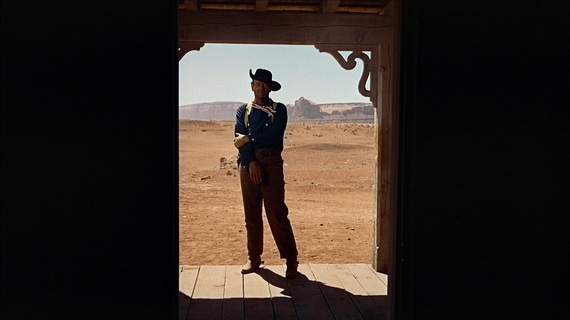
In Ford’s film, Ethan Edwards, played by John Wayne, ends the film by standing outside the cabin, framed by the shadow of the door, which separates the space into interior and exterior, the door being the threshold between spaces. The fact that Edwards is outside the door is important—the point to the audience is clear, Wayne’s character will always be an outsider, someone who will never be completely welcomed by those inside. And from what has happened already in the story, he will be also shunned by the Indian community, who will never regard him as one of their own. Unless he can walk over the threshold of the cabin door, or more to the point, unless he can be inside the house and not feel like an unwelcome stranger, he will always be an outsider, looking in.
Campion shows awareness of the doorway/framing visual device and chooses to use this scene at critical points in The Power of the Dog, not merely to show she knows a famous scene from a famous Western, but to expand its parameters. The “doorway shot” is seen in various locations throughout the film and when we first see Rose as a new wife in the Burbank house, the “doorway scene” from The Searchers is repeated, but the framing device has been changed from a door to a window. More importantly, in contrast to the problem faced by Ethan, Rose is inside the house looking out. Rose has become a threshold character like Ethan but is facing in the other direction—as Ethan Edwards has become captive of the landscape, she has become a captive of the house.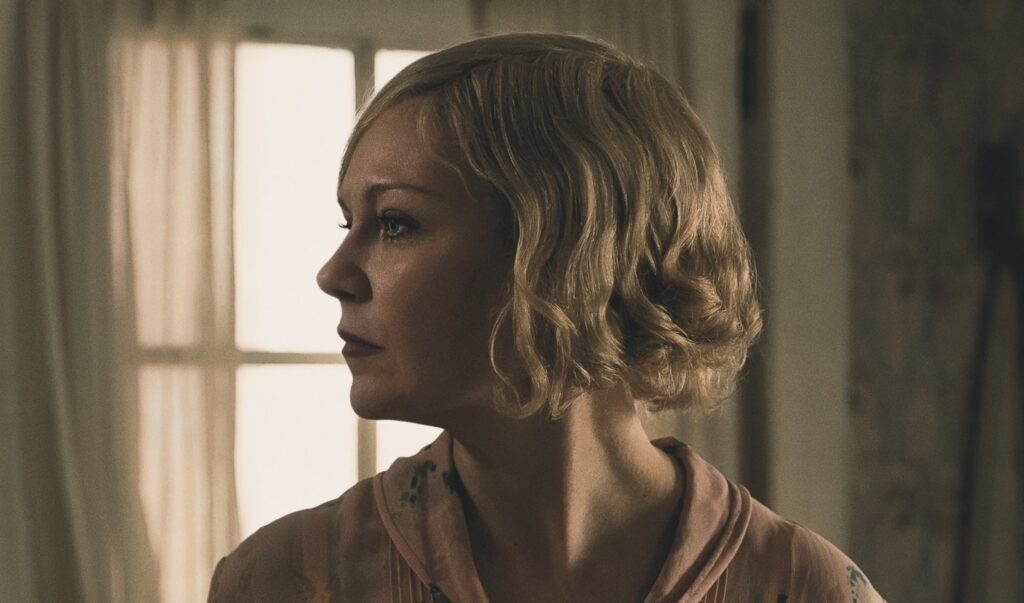
Yet Campion isn’t content with this clever inversion of a Western genre trope, she expands on the symbolism. As the story progresses and Rose feels increasingly trapped, there is a scene where she runs from one side of the house to the other, and with a tracking shot, we run with her, darting from one window to the next and the next—she is now bounded by multiple thresholds all telling her she must stay inside—her dilemma has been compounded. And because they are windows, there is an added functional component of being a tool of observation. She knows Phil has been following her every move, and the windows simply make his job easier, offering him multiple sites to record her shame and descent into alcoholism. Rose is faced with every window of the house reminding her of her loss of control, and because anything exterior to the house is what she perceives as Phil’s domain, each window allows one more chance for her personal privacy to be invaded.
Just one cabin door to walk through? Ethan Edwards didn’t know how easy he had it!
The visual cues and citations found throughout the film would mean little in themselves without a powerful story in which fully put them to use, and for this Campion has found a forgotten gem of a novel, written by Thomas Savage, and published in 1967. Power of the Dog was well reviewed in its day but sold poorly and was forgotten until it was republished in 2001. The novel has since been championed by reviewers and authors such as Annie Proulx, who has written an informative afterword in the current edition of the novel available as an e-book.
In her essay on Savage’s importance as a Western writer, Proulx describes Power of the Dog as a “regional classic” and classifies the work as being part of a “landscape genre” novel—the writers of this genre, she explains, include Willa Cather, William Faulkner, John Steinbeck, and “nearly all of what Hemingway wrote, all resonate with a sense of place.” In Savage’s novel, the central figure of the story is Phil, a man of superlative intellect and physical skills, and a man who is also gay. As he has grown up in a world where a man’s sexual preference to be with another man is inexpressibly abhorrent, his homosexuality is a fact he confronts and yet refuses to accept.
His response to this intractable psychic stalemate is that of a reaction formation. Not able to accept his homosexuality, Phil fashions himself to be the most manly of all men, to the point where he is outright homophobic, treating anyone who smacks of the slightest effeminacy with scorn and dismissal. But Phil’s scorn and hate is not limited to those might remind him of his own nature, it extends to anyone who shows weakness of any kind. Phil has developed an exquisite skill to psychologically determine the best way to attack those around him. Phil doesn’t need to use a gun to show his machismo prowess, his words are lethal by themselves. Years before, as if merely to demonstrate this ability, Phil took it upon himself to embarrass and shame a drunk to such a degree that the man ended up hanging himself.
Annie Proulx concludes her discussion of the novel by concluding that “with virtuoso skill, Savage created one of the most compelling and vicious characters in American literature.”
With these attributes, Savage has created a villain of overwhelmingly dangerous potential, a cowboy version of Richard III—not perhaps working his evil plans on such a large scale as Richard, but still as potentially deadly to those around him. And like Richard III, Phil has inherently sympathetic qualities; as an anti-hero, he can be admired at the same time he is abhorred.
As a villain, Phil lacks only an opponent who can truly appreciate his skills and has the capacity to challenge him at his own game. But this opponent, a young man named Peter, will soon enter the contest.
Proulx is the ideal spokesperson and advocate for the merits of The Power of the Dog, since this novel, and Savage’s writing overall, influenced her own work, most notably her short novel, Brokeback Mountain, which was published in 1997. Brokeback Mountain, a story set in Idaho from 1963 to 1983, is about the love between two gay men, a love that is constricted and confined both by society and their own upbringing, which in that era, continued to consider homosexuality as deviant and immoral.
The novels Power of the Dog and Brokeback Mountain, taken together, offer a potent commentary to the history of sexuality and sexual preference in the landscape of a Western rural environment in the beginning and middle of the twentieth century.
While Brokeback Mountain covers the years 1963-1983, by contrast, The Power of the Dog is set in the year 1925 (two generations before the events of Brokeback Mountain). The author, Thomas Savage, was born in 1915, and having grown up on a cattle ranch in Southern Idaho, would have been ten years old at the time the events in this novel take place; the details in the narrative are so exact as to give the sense we are reading a personal memoir.
Savage left Montana, went to college in Maine, married, wrote novels, and had three children. Only recently has it been revealed that Thomas Savage had his own secret life, becoming lovers with Tomie dePaola, a children’s book author and illustrator. After a year of turmoil, in which Savage left his wife and family, he eventually reconciled with his wife, and remained with her until her death in 1988. If events and characters in The Power of the Dog have the power and immediacy of autobiography, it is because Savage was drawing from his own memories and experiences.
Comparing these two novels to the film adaptions of both of their stories, if Annie Proulx’s fiction reminds me of Anton Chekov (and then ably translated into film by Ang Lee), the writing of Thomas Savage is firmly in the school of Patricia Highsmith (indeed, the novel Power of the Dog has been described as a “Cold Hearted Brokeback Mountain”). Seen with this lens, Campion’s adaptation, that is, the film version of The Power of the Dog begins to look more and more like a Hitchcock movie, especially by the third act, as the story transitions from mystery to thriller.
As in any well-constructed narrative, clues which give a foregrounding of future events are present almost from the beginning of the film—Peter as a young man is demonstrated to have interest in taxidermy, which serves notice to the direction of events to follow. Taxidermy is the study of bodies, or to more specific, the knowledge of preserving of the shell of the body. One might even say that taxidermy is the preservation of what houses the body.
It’s important to emphasize the focus on taxidermy is more than a plot point, it’s a central feature that emphasizes the story’s Gothic underpinnings. It is not by accident that the early references to taxidermy align with another famous movie where taxidermy is featured, Alfred Hitchcock’s Psycho, and as the film continues, the connections between the two films will become more obvious.
A key symbol of a Gothic tradition is a house or castle, or on a smaller scale, a room or enclosed space of some kind—this structure can represent confinement or a prison but can be also a defense to keep away those who want to expose a skeleton in the closet. Most Gothic enclosed spaces serve both functions at the same time—in Jane Eyre, for example, the locked attic in Thornfield Hall prevents Rochester’s first wife, Bertha Antoinetta Mason, from escaping but it also prevents others from gaining knowledge about her.
But a house or castle without a need for its use is, narratively speaking, wasted space. In a Gothic story, what gives this structure a reason for its presence is an inciting event: an evil deed, a gross and unfair misfortune, any act that can provoke guilt, shame, or resentment. Now charged with the job of protection and confinement, the house now assumes a personality and takes on the job of being protector, jailer, and even preserver.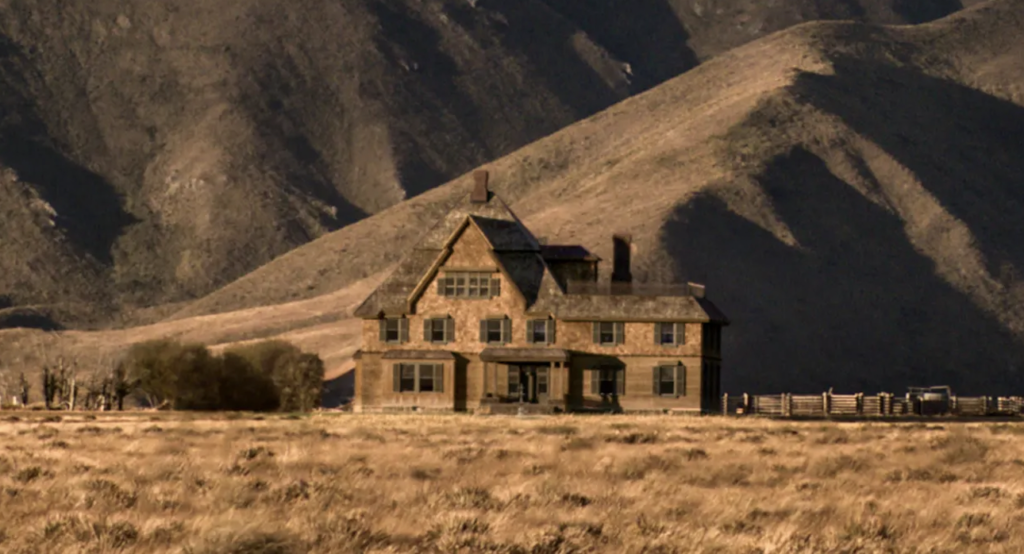
But any barrier, physical or mental, inherently has a time limit. Even castles cannot keep a persistent foe at bay forever. While this defense may work for a time, it only offers a temporary respite from the awareness of the growing encroachment from the exterior world. Its protection is finite, eventual permeability is inevitable. To refuse, to deny this reality invites disaster. Many Gothic stories use the denial to formulate invasion narratives, where the opponent, the ghost, the curse, (all of them being forms of guilt and its subsequent punishment) will penetrate one defense after another, until the last defense—your body itself—is breeched, and at that point, your soul itself will be left defenseless, ready to be judged and reaped.
For after all, what is the ultimate “house” than the body itself?
Subarna Mondal writes, “Throughout human history the body has been considered as highly volatile, one which has to be contained within a strict vigil to keep it from spilling over its boundary. The cultural construction of an indoctrinated body follows a predictable process: the destruction of a natural body, its recreation into a tamed version, and its constant patient preservation.”
Mondal is discussing the bodies found in Alfred Hitchcock’s Psycho, as he further explains: “The decaying body of Mrs. Bates, the deranged body of Norman Bates, and the tortured body of Marion Crane are studied as taxidermic recreations that not only reflect a taxidermist’s urge to construct compliant bodies but become sites of the creator’s and the viewer’s desire, much in the vein of a Gothic creation.”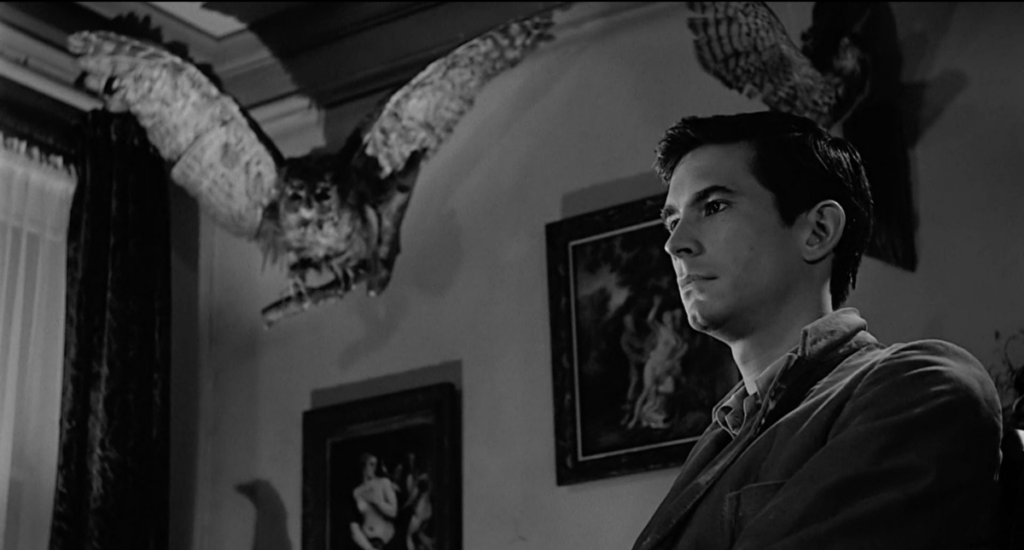
There are two elements of this disruption, the first is fragmentation of what inside the body (in the case of humans or animals, this means they are killed) and the second element is the act of preservation. “The very art of taxidermy encapsulates the contradictory notions of being and not-being. The attempts of mimicking life, of arresting movements, and of preserving a body that is both present and absent may serve as a metaphoric representation of what the Gothic projects, that is, the ever-present anxiety with the body thwarting all attempts at fixity.”
The character of Philip Glendale demonstrates this aspect of the Gothic in a textbook fashion, as for example his attempts to maintain preservation of the “golden moment” of his youth, a time just before his sexual preference toward men became nascent. For Phil, control of the rooms of the house become tantamount, even to the point of arranging objects such as books or magazines in same locations as when he was a boy, these objects fetishized into representing a safe harbor, a time and place that existed before the curse manifested itself (the discovery of his sexual orientation).
All these efforts become an exercise in futility as his George rebels against his brother by courting and marrying a widow, which leads to an invasion of outside forces (the introduction of Rose to the ranch). Phil’s response is to intensify the defense of his boundaries. Threatened as this “ghost” (in the form of Rose) progressively invades his private space, Phil responds by increased attempts to manipulate her to the point of causing her harm. Although obliquely mentioned in the film, the novel makes clear that the drunk man Phil shamed into hanging himself was Peter’s father, Johnny Gordon, and Phil will do all he can to make Rose meet the same fate.
And yet despite his rigidity in even keeping a strict vigil to keep his body fluids from “overspilling its boundary” in the most controlled manner possible, despite even his best efforts, Philip’s corporeal self fails him. The external shell of Phil, his skin but also in a metaphorical sense, his soul, becomes porous—as he lets down his guard and opens to the possibility of a friendship with Peter, his skin also becomes permeable and allows the spores of a bacteria to enter.
We as the audience watch with horrified expectation as Phil is exposed to the deadly anthrax and the bacteria finds its way first into his hand, and soon into his entire body, causing his death. Then comes a scene even more disturbing—with his body now controlled by others, his wild beard is shaved, his hair is groomed and meticulously combed, all of which transforms the transgressive and dangerous Philip Burbank into a placid and peaceful version of his formal self. Phil has been tamed. As with Mrs. Bates, the body found in Hitchcock’s Psycho, Phil has been become a “taxidermic recreation,” and a “compliant body.” If for only in a moment, death has provided for the Burbank family a son who is at last “normal.”
One of the features of Gothic literature is that it gives the author an ability to “target” a cultural fear about a belief or person (more formally described as the Other) by representing this fear in a slightly displaced form; the fear of Catholicism for example, could be shaped in the story of a woman who travels to a country where Catholicism is predominant and is held against her will by a monk. Or perhaps the fear is of a failed aristocracy, or even the fear of a foreigner. The Other could even come from closer to home and end up being merely a wayward or mysterious fiancée.
But since its beginnings, or at least since the novel Melmoth the Wanderer, written by Charles Maturin (Oscar Wilde’s great uncle), and published in 1820, and then with subsequent works such as Dr. Jekyll and Mr. Hyde in 1886, Gothic literature has also had the ability to encompass a “queer Gothic” component, where the author of the work can include homosexuality as one of the many sins, evil deeds, or transgressions that will eventually provoke a form of ultimate retribution. “Unspeakable” was a word commonly used in these “queer Gothic” texts, for as Maturin explains in Melmoth, the deed or act could not be spoken of because it was so “full of horror and impiety, that, even to listen to it, is scarce less a crime than to comply with it.”
Over time, the word “unspeakable” while maintaining an ability to mean whatever the writer (and the reader) wanted it to mean, also became a shibboleth, that is, a code word, to mean homosexuality. Sedgwick discusses the use of the word as an important trope used in Gothic fiction: “It’s more obvious referent is a Faustian pact, for Melmoth practices ‘that [nameless] art, which is held in just abomination by all ‘who name the name of Christ.’ The other half of the double meaning—the sexual half—excluded the exoteric portion of Maturin’s audience…Certainly, however, it meant something to Maturin’s great-nephew, Oscar Wilde. Seventy years later, forced to leave England after his disgrace and imprisonment for homosexual offenses, Wilde was to change his name to Melmoth.”
The art of working in a genre is to use its beats as a form of shorthand, but not to slavishly copy the form but rather, to add to it. The addition to the genre in Thomas Savage’s novel and then the adaptation by Jane Campion, is the addition of Peter, Rose’s son. It is implied that Peter is a homosexual, but he considers his sexuality not a curse but a fact of life. Peter has a clear-headed perception of what is going on around him, is comfortable with his own self, and knows he is—and was—loved by both his father and mother. His awareness of the outside world has a clarity so shorn of emotion that it borders on coldness.
In Savage’s novel, Johnny warns his son to be careful about his tendency to summarily reject and discard other people’s opinions:
“I would tell you, Peter, never to mind what people say. People can never know the heart of another.”
“I’ll never mind what people say.”
“And Peter, please don’t say it quite like that. Most who don’t mind—most of them grow hard, get hard. You must be kind, you must be kind. I think the man you will become could hurt people terribly, because you’re strong. Do you understand kindness, Peter?”
“I’m not sure whether I do, father.”
“Well, then. To be kind is to try to remove obstacles in the way of those who love or need you.”
Said with the most loving of intentions, these words, reframed, become justification for murder.
There is more than one ghost in The Power of the Dog—the most obvious ghost is the manifestation of Phil’s self-guilt about his homosexuality, but the second is Peter’s dead father, Johnny, whose words of advice about how to protect his mother clearly weigh on Peter’s mind. The advice is prescient (since she is truly at risk from Phil) yet laced with irony, since from Peter’s perspective it is a validation for his course of action.
And since Phil was responsible for the death of Johnny, there is perhaps a third spirit resembling the ghost of Hamlet’s father, as there is a hint of revenge in the air.
Seeing Phil’s anger when Rose sells the dried hides, Peter concludes Phil will not stop until Rose is either emotionally crushed or run off the ranch, and with this inevitable outcome, he formulates a plan to eliminate Phil before his mother is harmed. One of the great (and most Hitchcockian) ironies of the story is that the hero of the film will be a cold-blooded murderer.
The Power of the Dog, so rich with innuendoes and nuances, will not end with pat answers or an easily closed narrative. Near the end of the film, Peter removes the braided lasso from Phil’s room, and places it carefully below his bed. Is this act a way to safeguard others from exposure to a deadly disease? Or considering his prior interest in killing and preserving animals as taxidermy specimens for his own personal satisfaction, is Peter collecting a trophy? Is this the start of a pattern of behavior which will lead Peter down his own dark path?
And with Peter’s final act, even the meaning of the film’s title becomes unclear—if the “power of the dog” represents darkness and evil, who in the end is the dog: Phil or Peter?
As we peer deeply into the characters, their motivations, and their choices, there are no final answers, only more questions. And like a Wyeth painting, the knowledge we are seeing only part of a story—a story that will never have an answer—is profoundly disturbing.
We can only remember the advice of Peter’s father from beyond the grave, “No one can know the heart of another.”
List of Works Consulted:
Thomas Savage; The Power of the Dog, (1967) with an afterward by Annie Proulx (2001) Little, Brown and Company. Kindle Edition. Proulx gives us a compelling biography of Savage’s life and how it relates to the themes of The Power of the Dog. Taking note of his novels set in the Montana-Idaho-Utah area, she writes: “something aching and lonely and terrible of the west is caught forever on his pages, and the most compelling and painful of these books is The Power of the Dog, a work of literary art.”
Alan Weltzen “Thomas Savage’s Queer Country.” Boise State Scholar Works, Western Writers Online 2/6/2015, offers an excellent overview of Savage’s career, updating and expanding on the essay written by Proulx in 2001.
Eve Sedgwick, Between Men English Literature and Male Homosocial Desire (1985). This groundbreaking gender studies book upended generations of literary criticism regarding men, sex, and politics, and includes an illuminating chapter on how and why the Gothic novel became such an important venue of social transformation in the 18th and 19th century.
Helena Lamouliatte Angles, Open Edition Journals Andrew Wyeth and the Wyeth Tradition, or “the Anxiety of Influence” In this paper, Lamouliatte reviews and explains the importance of Gothic influences in Wyeth’s art.
Subarna Mondal “Did He Smile His Work to See?”—Gothicism, Alfred Hitchcock’s Psycho and the Art of Taxidermy, Palgrave Communications, Vol. 3, 2017. Mondal describes the various uses of body images and taxidermy in Alfred Hitchcock’s Psycho and discusses the importance of taxidermy to the Gothic genre.
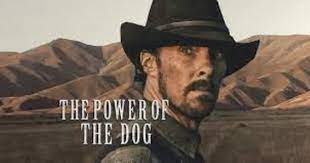



2 thoughts on “The Ghost Goes West: Jane Campion’s The Power of the Dog”
Fully agree. I described Power of the Dog as “Psycho with horses” when it first came out over here. Another possibility that we are offered is that Peter too is a serial killer at the beginning of his spree. He at least believes that the rope was still infected: so why jeep it unless its work is not done ?? And the gaze from his window at his mother and stepfather suggested to me that his mother may be widowed again soon…..and Peter gets his mother to himself again. The offer of the infected hides was obviously a deliberate one, he is a man/boy of science. The alacrity with which he disposes of the pet rabbit and disects it suggests a psychopathy; and apparently there is a cast interview out there that informs us that Kodi and Kirsten workshopped their own private family backstory, wherein Peter’s father was not actually a suicide but his first victim, covered up. That impression that I got, that possibility being offered, on first viewing was not entirely unconnected to Kodi’s resemblance to a young Anthony Perkins, not just playing a boy who loves and is loved by a mother just a little too much to be healthy. Peter’s Mother will be in her rocking chair for quite a while I suspect.
Mark, I agree with all your comments, you may want to read the novel, Power of the Dog – it got lost in the shuffle back in the 60s when it came out, but I think it’s one of the best American novels of the decade and deserves more attention. I think Campion took most of the themes of the novel and added a few of her own. Most reviews try to shoehorn this movie into a Western genre and I just see this Henry James version of Psycho, Jamesian in the sense that there is a deliberate ambivalence going on with the characters, so that it isn’t even clear who the heroes and villains are by the end of the film!